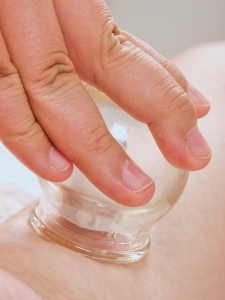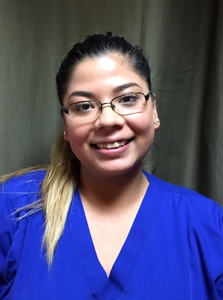
Cupping therapy can be performed with glass, silicon, or plastic cups that are suctioned onto the skin’s

Marisha Garcia, RMT
surface through negative pressure. The way the suction is created is different for each. Fire is briefly put into a glass cup to heat the inside the cup, which then creates a vacuum after the cup is applied to the skin and the air inside cools. Alternatively, plastic cups are coordinated with a manual vacuum pump to get the right suction. Lighter cupping is used for superficial muscles and myofascial tissues, or a medium or strong suction can be used for a deeper muscular release, depending on the area which is being treated. Cupping is very similar to deep tissue massage, where the pulling force of the suction places a specific stretch of the muscles, sinews and connective tissues. We, the therapist, slides the cup on the body to both elongate the muscle and break down adhesions in the surrounding connective tissue.
Cupping therapy has been around more than 5000 years. It first began in China where they used cattle horns. Here they ignited fire in the horns to create a negative pressure when then could expel pus and blood to treat boils. We know that in 755 AD cupping was used to treat tuberculosis, and about 300 years later the treatment was used for chronic cough and poisonous snake bites. Over time the original horn was replaced with bamboo, ceramic, or glass cups until now they vary regarding materials and sizes and ways to create a vacuum.
The different types of cups are glass, plastic and silicone cups. If you are trying cupping for the first time I recommend trying the silicone cups because they can be more comfortable than the glass, and can be slid easily with the muscle. Many patients benefit from alternating cupping with a regular massage during the treatment; you can discuss with your therapist in what way and how frequently you want to incorporate cupping into your treatment plan.
Cupping can be done on the body anywhere from arms and shoulders, the back and neck, upper glutes, sacrum, hamstrings, quadriceps, Iliotibial band, and calf muscles. Even around the knee helps release the insertion points for the leg muscles. Traditional, oriental medicine uses cupping for pain syndromes, but also for a variety of general conditions such as, asthma, the common cold, digestive diseases, skin conditions and chronic cough. Indeed, cupping can benefit anyone with joint or muscle tension, and even headaches. Clients that should steer away from cupping would be someone that has been fasting, or are physiologically deficient in some way as with a chronic illness, as the body is too weak. Also, as with massage, anyone who has a severe muscle or ligament sprain, or a complete tendon rupture should not be using manual therapies like cupping. Clients on blood thinners or bleeding disorders should be monitored carefully if they are getting cupping.
Cupping not only loosens adhesions in the myofascial and muscle tissues, but also can stimulate better function in the lymphatic system, increase blood flow to muscles, connective tissues and skin. The lymphatic system is important for the body, since it represents an essential fluid conduction system for the body’s defensive mechanism to monitor for foreign material and bacteria, and ultimately to recruit white blood cells to control these. During cupping therapy, both the blood and lymph circulation are increased, which means a more efficient collection and transportation of wastes moved through the lymphatic system to be processed by the liver and excreted by the kidneys. In turn, the circulation of fresh lymph and improved blood flow then nourishes the tissues and generates an increased immunological capacity. Clients feel a decrease in local pain that was caused by stagnant substances associated with inflammation and lactic acid, and a faster healing of these tissues.
Cupping causes an increase in blood flow to the local area, and in turn will cause “extravasation” of fluids and sometimes blood in the area. The fluid and blood discharged from the blood vessels causes a marking on the skin looking like a bruise, which can take several days for the tissue to metabolize and reabsorb. Your body really reacts to the extrusion of the blood in the soft tissues and interstitial spaces. This therapeutic intervention mimics an injury response, but with the injury! Your body then works hard to rejuvinate the affected area. When the body is eliminating the secretion of blood, there is an increased in white blood cells which then also increases the immune system. The metabolize agents that are created during cupping increases the formation of new tissue, which in turn ultimately resolve the original stagnation and chronic inflammation. Cupping stimulates an improved local blood flow also affects the nervous system by stimulating the sensory nerves of the skin, to restore the normal responsiveness and reflexes of health tissue.
After a cupping treatment, some people can be sore or even have a strong emotional response, as is the case with massage. I always advise my clients to take care after, don’t plan a high performance activity after work or play, and to drink a lot of water to help flush out the metabolic wastes being released. If needed apply a warm compress or have a shower after to further promote blood flow, lymphatic drainage and healing. As a massage therapist, cupping is a great therapy for clients who need a more complex release on muscles, trigger points, and connective tissue. I highly recommend this effective therapy. Trying out new things can be intimidating, but cupping therapy gives such a wonderful release in the muscles, trying it once can change your perspective about those weird looking marks!




